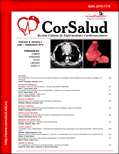Variabilidad clínica, imagenológica y quirúrgica del pseudoaneurisma posquirúrgico de la aorta ascendente. Informe de tres casos
Resumen
Los pseudoaneurismas posquirúrgicos de la aorta ascendente presentan un cuadro clínico muy variado, y se manifiestan desde una forma asintomática hasta un cuadro tóxico infeccioso grave o la rotura. También expresan diversidad en cuanto a localización, tiempo de aparición posterior a la primera cirugía y hallazgos quirúrgicos. Se presentan tres casos operados en el Servicio de Cirugía Cardiovascular del Hospital “Hermanos Ameijeiras”, en un período de cuatro años. El primero es un paciente operado de comunicación interauricular que días después de su cierre quirúrgico comenzó con un cuadro febril. El segundo caso es una paciente que tres meses posteriores a una cirugía de sustitución valvular aórtica se diagnostica el pseudoaneurisma, donde se recoge, como único antecedente, cuadros febriles a repeticiones; y el tercero, es un enfermo que había sido intervenido de coartación aórtica y al año siguiente, de reemplazo de la valvula aórtica; 17 años más tarde comenzó con dolor precordial, astenia y pérdida de conciencia. Los pseudoaneurismas posquirúrgicos aórticos constituyen un desafío para todos los servicios de cardiología y cirugía cardiovascular, pues muestran gran variedad en sus formas de presentación clínico-quirúrgicas.Descargas
Los datos de descargas todavía no están disponibles.
Descargas
Publicado
2014-07-04
Cómo citar
1.
Valdés-Dupeyrón O, Nafeh-Abiz Reck M, Villar-Inclán A, Hernández-Núñez R, Carballo-Hidalgo RN, Rodríguez-Rey K, et al. Variabilidad clínica, imagenológica y quirúrgica del pseudoaneurisma posquirúrgico de la aorta ascendente. Informe de tres casos. CorSalud [Internet]. 4 de julio de 2014 [citado 17 de diciembre de 2025];6(3):259-65. Disponible en: https://revcorsalud.sld.cu/index.php/cors/article/view/162
Número
Sección
CASOS CLÍNICOS
Licencia
Aquellos autores/as que tengan publicaciones con esta revista, aceptan los términos siguientes:- Los autores/as conservarán sus derechos de autor y garantizarán a la revista el derecho de primera publicación de su obra, el cuál estará simultáneamente sujeto a la Licencia de reconocimiento de Creative Commons que permite a terceros compartir la obra siempre que se indique su autor y su primera publicación esta revista.
- Los autores/as podrán adoptar otros acuerdos de licencia no exclusiva de distribución de la versión de la obra publicada (p. ej.: depositarla en un archivo telemático institucional o publicarla en un volumen monográfico) siempre que se indique la publicación inicial en esta revista.










